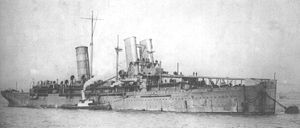HMS Campania (1914)

HMS Campania after her second refit
|
|
| History | |
|---|---|
|
|
|
| Name: | HMS Campania |
| Builder: | Fairfield, Glasgow, Scotland |
| Laid down: | 1892 |
| Launched: | 8 September 1892 |
| Acquired: | 27 November 1914 |
| Commissioned: | 17 April 1915 |
| Fate: | Sank in the Firth of Forth, 5 November 1918 |
| General characteristics | |
| Type: | Aircraft/Seaplane carrier |
| Displacement: | 20,570 long tons (20,900 t) |
| Length: | 622 ft (189.6 m) |
| Beam: | 65 ft (19.8 m) |
| Draught: | 28 ft 5 in (8.7 m) |
| Installed power: | 28,000 ihp (21,000 kW) |
| Propulsion: | 2 × shafts, 2 × 5-cylinder VTE steam engines |
| Speed: | 19.5 kn (36.1 km/h; 22.4 mph) |
| Complement: | 600 |
| Armament: |
|
| Aircraft carried: | 10–12 |
| Aviation facilities: | 1 × flying-off deck forward |
HMS Campania was a seaplane tender and aircraft carrier, converted from an elderly ocean liner by the Royal Navy early in the First World War. After her conversion was completed in mid-1915 the ship spent her time conducting trials and exercises with the Grand Fleet. These revealed the need for a longer flight deck to allow larger aircraft to take off, and she was modified accordingly. Campania missed the Battle of Jutland in May 1916, but made a number of patrols with elements of the Grand Fleet. She never saw combat and was soon relegated to a training role because of her elderly machinery. In November 1918 Campania was anchored with the capital ships of the Grand Fleet when a sudden storm caused her anchors to drag. She hit several of the ships and the collisions punctured her hull; she slowly sank, with no loss of life.
Originally built as a passenger liner for Cunard Line's service between Liverpool and New York in 1893, RMS Campania was the holder of the Blue Riband award for speed early in her career. In October 1914, she was sold to the shipbreakers Thos W Ward as she was wearing out.
The Royal Navy purchased Campania from the shipbreakers on 27 November 1914 for £32,500, initially for conversion to an armed merchant cruiser equipped with eight quick-firing 4.7-inch (120 mm) guns. The ship was converted by Cammell Laird to an aircraft carrier instead and the two forward 4.7-inch guns were deleted in favour of a 160-foot (48.8 m) flying-off deck. Two derricks were fitted on each side to transfer seaplanes between the water and the two holds. The amidships hold had the capacity for seven large seaplanes. The forward hold, underneath the flight deck, could fit four small seaplanes, but the flight deck had to be lifted off the hold to access the airplanes. HMS Campania was commissioned on 17 April 1915.
...
Wikipedia
